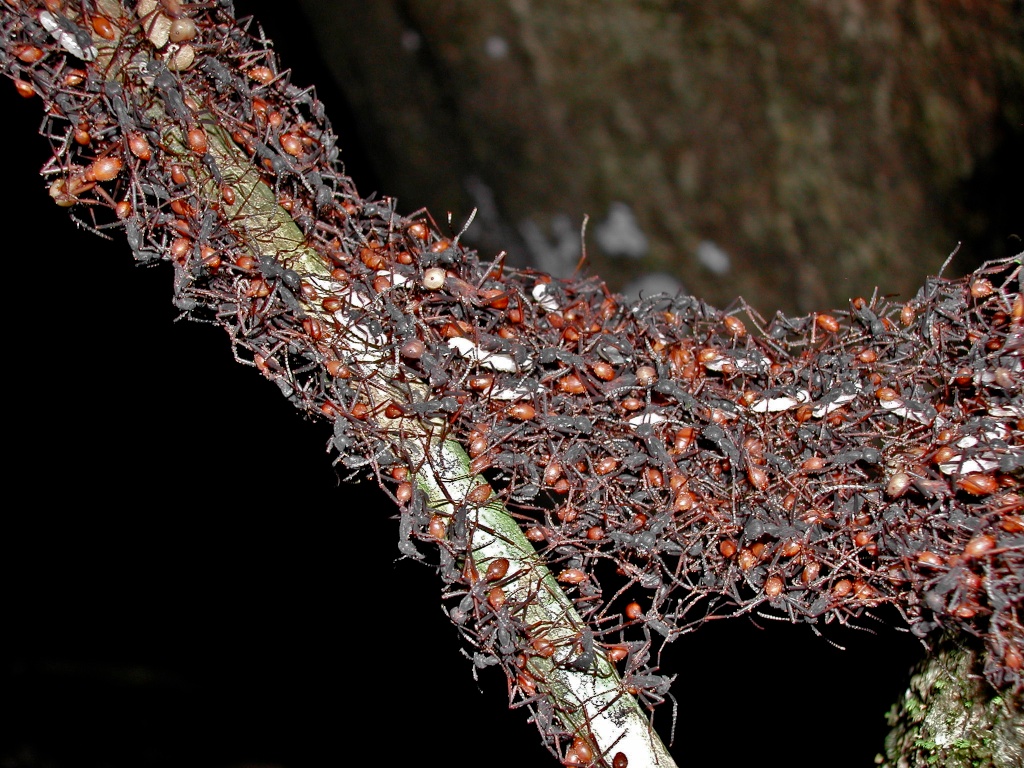WHY ANTS?
We work with ants because they provide beautiful examples of some of the most important, general processes that evolutionary ecologists seek to understand. Ants are one of the great evolutionary success stories: They have diversified into an incredible array of terrestrial niches worldwide, driving the evolution of remarkable suites of adaptations, and are currently represented by about 13,000 known species. In contemporary communities, this great evolutionary success translates into high local species richness, as well as astonishing abundance and ecological footprint via their diverse trophic interactions. Ants are, of course, also one of the most striking examples of organisms that have undergone the major evolutionary transition to living in functionally interdependent societies. This adds fascinating layers of complexity to both their phenotypic diversification and their ecological interactions. Within the ants, we work mostly with a few groups that are particularly special and informative for our main questions of interest. More on these ants below.
TURTLE ANTS
Much of our current work is with the arboreal ant genus Cephalotes, commonly known as the turtle ants. This group is strictly limited to the New World and most are found only in the Neotropics. They are special for a couple of reasons.
First, the group shows exceptional levels of eco-morphological diversity across the 118+ known species. This includes a five-fold difference in body length between the workers of the smallest and largest species (the smallest could comfortably ride on the head of the largest!), elaborate body armor consisting of spines and lateral shielding in the workers of all species, and soldiers in most species. The extreme shell-like lateral shielding (extensions of the exoskeleton) seen in the workers of some species gives the group their common name: workers pull their appendages under their shell and press their body against the substrate when threatened. This "turtling behavior", in combination with their extensive body armor, protects these ants while they forage in the hostile canopy environment. Back at their nests, typically established in the abandoned tunnels of wood-boring beetles, the ants defend themselves by blocking the nest entrances with their heads. In most species, this is done by soldiers specialized for the job. Soldiers have enlarged and heavily thickened head capsules. Among species, soldiers vary in distinct morphotype, and head size and shape. In the most elaborate examples, soldiers have complete, strongly concave dorsal head disks that they can mechanically lock into place in well-fitting entrances holes. Critical for us, the foraging ecology of workers, the nesting ecology of the colony, and the defensive behaviors of the soldiers are accessible and experimentally tractable in the low canopy of the Brazilian cerrado, where we conduct most of our field work.
The second special aspect of turtle ant biology is that in most tropical systems, including our cerrado study sites, these ants are locally diverse. This included both raw species richness and various aspects of phylogenetic diversity. From a species richness perspective, we have located up to 18 species in individual cerrado sites. These local assemblages also typically span a broad phylogenetic sampling of taxa that includes multiple sister pairs, as well as geographically widespread species and cerrado endemics. This gives us a tremendous diversity of species to work with for all aspects of our research on the ecology of trait diversification, and especially the experimental studies of trait function.
ARBOREAL ANTS OF THE CERRADO
For our work on trait-mediated community assembly, we expand out from our work on turtle ants to include the whole arboreal ant community of our cerrado study sites. We have recorded over 90 arboreal ant species in our primary study site, spanning 17 genera and 6 subfamilies, and up to 20 species on individual trees. In addition to this high diversity of ants, we see remarkably clean division between arboreal and ground-nesting taxa, despite the small stature of the the trees. This combination of diverse and distinct arboreal communities, and the exceptional access we have to the low canopy makes for a level of manipulative experimental work not achievable in other Neotropical arboreal systems.
Our whole-community questions build directly from the insights we gain into the biology of turtle ants. We know that the properties of beetle-produced cavities have had a central role in shaping turtle ant evolution, and that they impact the nesting dynamics of individual species and colonies in contemporary assemblages. Consequently, we are particularly focused on understanding whether the interaction between the properties of available beetle-produced cavities interact with the traits of cavity-nesting ants to have a significant impact on the assembly of arboreal ant communities as a whole. This primary focus intersects with other questions related to the potential influence on assembly of food resources, and the cascading effects of changes in local tree-level ant assemblages on trophic interactions.
ARMY ANTS
New World army ants (Formicidae: Ecitoninae) are all nomadic social predators: colonies relocate regularly and foraging is always conducted in group-raids, with a large number of workers simultaneously seeking-out and capturing prey cooperatively. Colonies can number in the tens to hundreds of thousands of individuals. Consequently, army ants are exceptional examples of collective phenotypic traits and behaviors. We have a special interest in using these ants to understand the evolution of predator-prey combat strategies, the impact of predators on prey communities, individual and collective load transport, and collective structures built by the ants to maximize load delivery.












